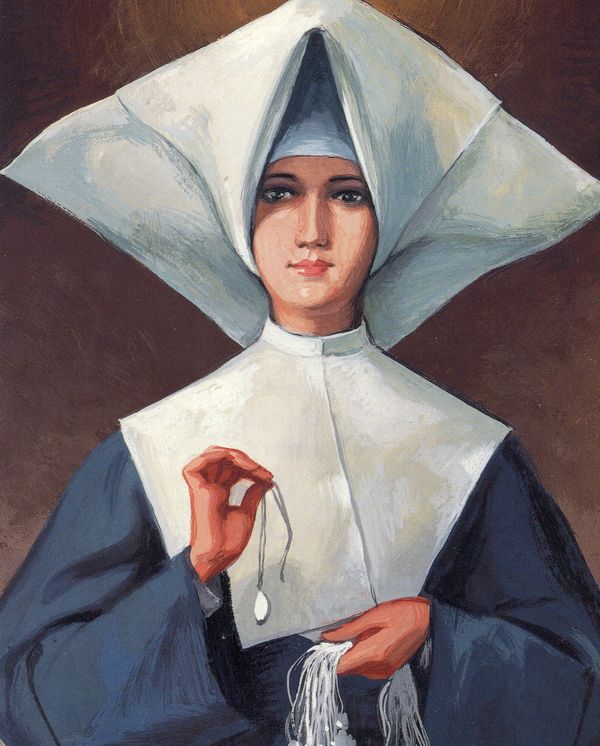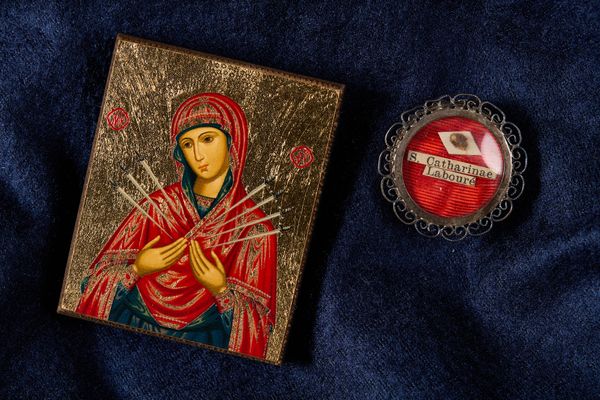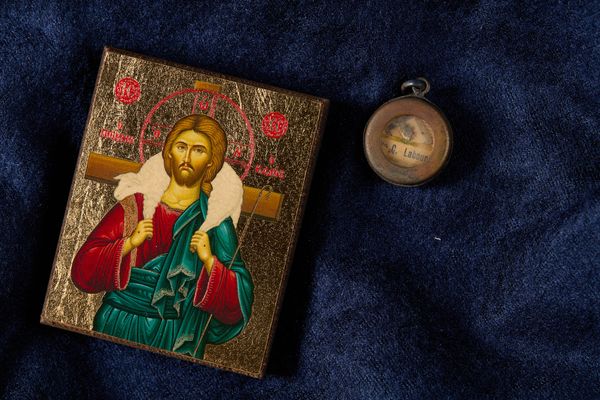Labouré was born on 2 May 1806, in the Burgundy region of France to Madeleine Louise Gontard and Pierre Labouré, a farmer. She was the 9th of 11 living children. Her baptismal name was Zoe, but her family rarely used that name. Labouré's mother died on 9 October 1815, when Labouré was nine years old. It is said that after her mother's funeral, Labouré picked up a statue of the Blessed Virgin Mary and kissed it, saying, "Now you will be my mother."
Her father's sister offered to care for her and her sister Marie Antoinette and the sisters moved to their aunt's house at Saint-Rémy, a village 9 kilometres (5.6 mi) from their home. It is there that Catherine had a dream of a priest, whom she later recognised as Vincent de Paul. The priest said to her: 'My daughter, it is good to care for the sick. For now, you flee from me, but one day you will be glad to approach me. God has plans for you. Don't forget it!'.
At the age of 12, Catherine returned to her father's farm to help care for her family. Later, her father, wishing to deter her from her religious vocation, sent her to Paris to work in his brothers’ eating establishment for poor workers. There, she observed their suffering and her decision to enter the nursing order of Saint Vincent de Paul, the Daughters of Charity, was reinforced.
Visions of Mary
iLabouré stated that on July 19, 1830, the eve of the feast of St. Vincent de Paul, she woke up after hearing the voice of a child calling her to the chapel, where she heard the Virgin Mary say to her, "God wishes to charge you with a mission. You will be contradicted, but do not fear; you will have the grace to do what is necessary. Tell your spiritual director all that passes within you. Times are evil in France and in the world".
On November 27, 1830, Labouré reported that Mary returned to her during evening meditations. She displayed herself inside an oval frame, standing upon a globe; rays of light came out of her hands in the direction of a globe. Around the margin of the frame appeared the words "O Mary, conceived without sin, pray for us who have recourse to thee." As Labouré watched, the frame seemed to rotate, showing a circle of twelve stars, a large letter M surmounted by a cross, and the stylized Sacred Heart of Jesus and Immaculate Heart of Mary underneath. Asked why some of the rays of light did not reach the earth, Mary reportedly replied, "Those are the graces for which people forget to ask." Mary then asked her to take these images to her father confessor, telling him that they should be put on medallions. "All who wear them will receive great graces."
Labouré did so, and after two years of investigation and observation of her normal daily behavior, the priest took the information to his archbishop without revealing her identity. The request was approved and the design of the medallions was commissioned through French goldsmith Adrien Vachette. They proved to be exceedingly popular—the Miraculous Medal was quickly adopted by millions of the Catholic faithful. It also played an important role in the proclamation by Pope Pius IX of the Immaculate Conception on December 8, 1854. The dogma of the Immaculate Conception had not yet been officially promulgated, but the medal, with its "conceived without sin" slogan, was influential in popular approval of the idea.
Canonization
Labouré died in the Hospice on December 31, 1876, at the age of 70. Her body was later moved and is now encased in glass beneath the side altar in the Chapel of Our Lady of Graces of the Miraculous Medal in 140 Rue du Bac, Paris.
Her cause for sainthood was declared upon discovery that her body was incorrupt. She was beatified on May 28, 1933, by Pope Pius XI and canonized on July 27, 1947, by Pope Pius XII.


